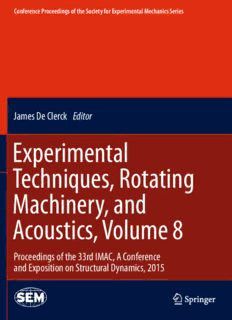Table Of ContentConference Proceedings of the Society for Experimental Mechanics Series
James De Clerck Editor
Experimental
Techniques, Rotating
Machinery, and
Acoustics, Volume 8
Proceedings of the 33rd IMAC, A Conference
and Exposition on Structural Dynamics, 2015
Conference Proceedings of the Society for Experimental Mechanics Series
SeriesEditor
TomProulx
SocietyforExperimentalMechanics,Inc.,
Bethel,CT,USA
Moreinformationaboutthisseriesathttp://www.springer.com/series/8922
James De Clerck
Editor
Experimental Techniques, Rotating
Machinery, and Acoustics, Volume 8
Proceedings of the 33rd IMAC, A Conference and Exposition
on Structural Dynamics, 2015
123
Editor
JamesDeClerck
TheEnterpriseProgram
MichiganTechnologicalUniversity
Houghton,MS,USA
ISSN2191-5644 ISSN2191-5652 (electronic)
ConferenceProceedingsoftheSocietyforExperimentalMechanicsSeries
ISBN978-3-319-15235-6 ISBN978-3-319-15236-3 (eBook)
DOI10.1007/978-3-319-15236-3
LibraryofCongressControlNumber:2015935738
SpringerChamHeidelbergNewYorkDordrechtLondon
©TheSocietyforExperimentalMechanics,Inc.2015
Thisworkissubjecttocopyright.AllrightsarereservedbythePublisher,whetherthewholeorpartofthematerialisconcerned,specificallytherights
oftranslation, reprinting, reuse ofillustrations, recitation, broadcasting, reproduction onmicrofilms orinany other physical way, and transmission or
informationstorageandretrieval,electronicadaptation,computersoftware,orbysimilarordissimilarmethodologynowknownorhereafterdeveloped.
Theuseofgeneraldescriptivenames,registerednames,trademarks,servicemarks,etc.inthispublicationdoesnotimply,evenintheabsenceofaspecific
statement,thatsuchnamesareexemptfromtherelevantprotectivelawsandregulationsandthereforefreeforgeneraluse.
Thepublisher,theauthorsandtheeditorsaresafetoassumethattheadviceandinformationinthisbookarebelievedtobetrueandaccurateatthedateof
publication.Neitherthepublishernortheauthorsortheeditorsgiveawarranty,expressorimplied,withrespecttothematerialcontainedhereinorforany
errorsoromissionsthatmayhavebeenmade.
Printedonacid-freepaper
SpringerInternationalPublishingAGSwitzerlandispartofSpringerScience+BusinessMedia(www.springer.com)
Preface
ExperimentalTechniques,RotatingMachinery&Acoustics,representsoneoftenvolumesoftechnicalpaperspresentedatthe
33rdIMAC,AConferenceandExpositiononStructuralDynamics,2015organizedbytheSocietyforExperimentalMechan-
ics, andheldin Orlando,FloridaFebruary2–5,2015.Thefullproceedingsalso includevolumeson NonlinearDynamics;
DynamicsofCivilStructures;ModelValidationandUncertaintyQuantification;SensorsandInstrumentation;SpecialTopics
inStructuralDynamics;StructuralHealthMonitoring&DamageDetection;Shock&VibrationAircraft/Aerospace,Energy
Harvesting;andTopicsinModalAnalysis.
Each collection presents early findings from experimental and computational investigations on an important area
within Structural Dynamics. Topics in Modal Analysis I represents papers on enabling technologies for Modal Analysis
measurementssuchasSensors&Instrumentation,andapplicationsofModalAnalysisinspecificapplicationareas.Topics
inthisvolumeinclude:
ExperimentalTechniques
ProcessingModalData
RotatingMachinery
Acoustics
AdaptiveStructures
Biodynamics
Damping
Theorganizerswouldliketothanktheauthors,presenters,sessionorganizers,andsessionchairsfortheirparticipationin
thistrack.
Houghton,MS,USA J.DeClerck
v
Contents
1 AComputationalModeltoInvestigatetheInfluenceofSpacingErrorsonSpurGearPairDynamics....... 1
MuratInalpolat
2 DrillVibrationSuppressionThroughPhase-LockedLoopControl............................................... 11
NicholasMartinez,JermaineChambers,MichelleGegel,EricSchmierer,andAlexScheinker
3 TowardstheSelectionofBalancingPlanestoAttainLowVibrationsinFlexibleRotorMotorSystems...... 21
SumitSinghalandKumarVikramSingh
4 ExperimentalAcousticModalAnalysisofanAutomotiveCabin.................................................. 33
G.Accardo,M.El-kafafy,B.Peeters,F.Bianciardi,D.Brandolisio,K.Janssens,andM.Martarelli
5 UncorrelatedNoiseSourcesSeparationUsingInverseBeamforming............................................. 59
ClaudioColangeli,PaoloChiariotti,andKarlJanssens
6 ActiveNoiseControlExperimentMinimisingRadiation
ofActiveEnergy ......................................................................................................... 71
UliKrauseandDelfSachau
7 ActiveControlofTransformerNoisebyMIMOAlgorithm........................................................ 77
J.M.LiuandW.D.Zhu
8 NumericalPredictionToolsforLow-FrequencySoundInsulationinLightweightBuildings .................. 85
JuanNegreiraandDelphineBard
9 ReductionofRadiatingSoundfromCFRPLaminatedPlateswithOrthotropy................................. 97
NobuyukiOkubo,YukiIzumi,TakeshiToi,HideyukiMuramatsu,andYujiNaito
10 RotatingDiscModelforComplexEigenvalueAnalysisofBrakeSqueal ......................................... 107
YujianWang,YongchangDu,andPuGao
11 ValidationofClosed-LoopCouplingDiscBrakeModel
forSquealAnalysis...................................................................................................... 113
PuGao,YongchangDu,andYujianWang
12 EstimationofTorsionalCompliance(Stiffness)fromFree-FreeFRFMeasurements:eRCFTheory......... 121
HasanG.Pasha,RandallJ.Allemang,AllynW.Phillips,AlexanderYoung,andJeffPoland
13 AnEstimationofTorsionalCompliance(Stiffness)fromFree-FreeFRF
Measurements:eRCFApplication..................................................................................... 133
JeffreyPoland,AlexanderYoung,HasanPasha,RandallAllemang,andAllynPhillips
14 EstimationofBendingCompliance(Stiffness)fromFree-FreeFRFMeasurements:eBCFTheory........... 141
HasanG.Pasha,R.J.Allemang,A.W.Phillips,A.Young,andJ.Poland
15 In-SituExperimentalModalAnalysisofaDirect-DriveWind
TurbineGenerator....................................................................................................... 157
M.Kirschneck,D.J.Rixen,HenkPolinder,andRonvanOstayen
vii
viii Contents
16 EffectofRadialConfinementonWavePropagationandVibrationalResponseinBars........................ 167
JacobC.Dodson,JasonR.Foley,JanetC.Wolfson,JonathanHong,VincentLuk,AlainBeliveau,
andAlexanderIdesman
17 ComponentQualificationUsing3DLaserVibrometryandTransmissibilityModels ........................... 181
D.J.MacknellyandP.R.Ind
18 ExploitingContinuousScanningLaserDopplerVibrometryandWaveletProcessing
forDamageDetection................................................................................................... 189
P.Chiariotti,G.M.Revel,andM.Martarelli
19 Useof3DScanningLaserVibrometerforFullFieldStrainMeasurements...................................... 197
JesusM.ReyesandPeterAvitabile
20 InlineMeasurementsofRailBendingandTorsionThroughaPortableDevice.................................. 211
S.Bionda,F.Braghin,D.Milani,andE.Sabbioni
21 FortyYearsofUseandAbuseofImpactTesting:APracticalGuideto
MakingGoodFRFMeasurements .................................................................................... 221
DavidL.Brown,RandallJ.Allemang,andAllynW.Phillips
22 DetectionofCouplingMisalignmentbyExtendedOrbits .......................................................... 243
MichaelMonte,FlorianVerbelen,andBramVervisch
23 LinearandNonlinearResponseofaRectangularPlateMeasuredwithContinuous-ScanLaser
DopplerVibrometryand3D-DigitalImageCorrelation............................................................ 251
DavidA.Ehrhardt,ShifeiYang,TimothyJ.Beberniss,andMatthewS.Allen
24 VibrationEventLocalizationinanInstrumentedBuilding ........................................................ 265
JavierSchloemann,V.V.N.SriramMalladi,AmericoG.Woolard,JosephM.Hamilton,
R.MichaelBuehrer,andPabloA.Tarazaga
25 LoadingEffectonInductionMotorEccentricityDiagnosticsUsingVibrationandMotorCurrent........... 273
GaneriwalaSuri
Chapter 1
A Computational Model to Investigate the Influence of Spacing Errors
on Spur Gear Pair Dynamics
MuratInalpolat
Abstract In this paper, a computational model is developed to investigate the influence of tooth spacing errors on the
dynamicsof spur gear pairs. This finite element based computationalmodelimplicitly includes periodically-timevarying
gear mesh stiffness and nonlinearitiescaused by tooth separationsin resonanceregions. The modelcan simulate the long
periodtransmissionerrorinduceddynamicresponsefromaspurgearwithdifferentspacingerrorpatternsandpredictsboth
timedomainhistoriesandfrequency-domainspectraofdynamicmeshforceanddynamictransmissionerror.Thedynamic
responsesduetobothdeterministicandrandomteethspacingerrorsarepredictedandcomparedtothepreviouslygenerated
results from a lumped parameter model capable of utilizing experimentally measured transmission error as the realistic
excitationmechanism.Thisstudyalsoenablescreationofanextensivedatabaseofdynamicresponsespectraofgearpairs
undertheinfluenceofspacingerrorsthatwilllaterbeutilizedforinvestigatingthediagnosticsofgearpairs.
Keywords Spacingerrors • Dynamics • Nonlineareffects • Contact • Manufacturing
1.1 Introduction
Gearmanufacturingconstitutesthedecisionandimpositionofacertainqualitylevel.Theimposedqualitylevelisspecified
basedupontherequirementsoftheapplicationandeventhegearswiththehighestqualitylevelswillhavecertainamountof
manufacturingerrors(tolerances).Thesemanufacturingerrorsandtolerancescontributetotheloadedtransmissionerrorthat
affectsthemeshingdynamicsofgearpairs.Moreover,itisdesignandsometimesassemblydependenthowthesedifferent
amountsoferrorsongearsinmeshactuponeachotherandaffecttheresultantgeardynamics.Consequently,understanding
theroleandeffectofdifferentgeardesignandmanufacturingbasederrorsandtolerancesonthetransmissionerrorsofgears
is important.One ofthe mostsignificantcontributorsto the geartransmissionerroris thetoothspacingerrors.Gear tooth
spacingerrorisdefinedasthecircumferentialpositionerrorofonegeartoothflankwithrespecttotheprevioustoothflank
asillustratedinFig.1.1[1].Here,consecutiveteetharelocatedonareferencediameter(usuallypitchdiameter)ofagear.
In an ideal situation, a particular gear has Z number of teeth that have identical involute profiles that are equally spaced
around the pitch diameter. Existence of spacing error means that some of the tooth profiles are angularly misplaced from
their idealpositionwith respectto theteeth adjacentto them.Thereferencetooth(index)ischosenasTooth-1in Fig. 1.1
withoutlossofgenerality.TherighthandsideflankofTooth-1isthereferenceprofile(flank)whencertainamountoftorque
actingintheclockwisedirectionisassumedtoexistonthisgear.Thecirculardistances,S1andS2,betweentherightflanks
ofTooth-1andTooth-2andalsobetweenTooth-2andTooth-3,wherebothflanksintersectthereferencediameterareboth
equaltoacircularpitchp(p D(cid:2):m)foragearwithidealgeometry.IfS1deviatesfromthenominalcircularpitchpthenthe
differenceisinterpretedasthespacingerror" forTooth-2.Similarly,ifS2hasadifferentvaluethanpthenitisinterpreted
1
asthespacingerror" forTooth-3.
2
Gear tooth spacing errorsarise duringthe manufacturingprocesses and in many cases have periodicitiesrelated to the
cuttingorheattreatmentprocessinadditiontotherandomcomponents[2].Periodicitiesintransmissionerrorfunctionare
usuallyloworderandtendtoresultinamplitudeandphasemodulationofthegeardynamicmeshforces.Iftransmissionerror
isofthisform,therewillbeanumberofsidebandswithsignificantenergycontentlocatedaroundthetoothmeshorderand
itsmultiples.Itisvitaltounderstandthedegreeofmodulationsasitisareflectionofthetypeandamountofmanufacturing
errorsthatexistonthegears.
M.Inalpolat((cid:2))
StructuralDynamicsandAcousticSystemsLaboratory,UniversityofMassachusettsLowell,OneUniversityAvenue,Lowell,MA01854,USA
e-mail:[email protected]
©TheSocietyforExperimentalMechanics,Inc.2015 1
J.DeClerck(ed.),ExperimentalTechniques,RotatingMachinery,andAcoustics,Volume8,ConferenceProceedings
oftheSocietyforExperimentalMechanicsSeries,DOI10.1007/978-3-319-15236-3_1
Description:Experimental Techniques, Rotating Machinery & Acoustics, Volume 8: Proceedings of the 33rd IMAC, A Conference and Exposition on Structural Dynamics, 2015, the eighth volume of ten from the Conference brings together contributions to this important area of research and engineering. The collection pre

